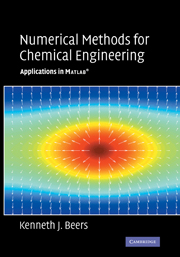Book contents
- Frontmatter
- Contents
- Preface
- 1 Linear algebra
- 2 Nonlinear algebraic systems
- 3 Matrix eigenvalue analysis
- 4 Initial value problems
- 5 Numerical optimization
- 6 Boundary value problems
- 7 Probability theory and stochastic simulation
- 8 Bayesian statistics and parameter estimation
- 9 Fourier analysis
- References
- Index
7 - Probability theory and stochastic simulation
Published online by Cambridge University Press: 05 June 2012
- Frontmatter
- Contents
- Preface
- 1 Linear algebra
- 2 Nonlinear algebraic systems
- 3 Matrix eigenvalue analysis
- 4 Initial value problems
- 5 Numerical optimization
- 6 Boundary value problems
- 7 Probability theory and stochastic simulation
- 8 Bayesian statistics and parameter estimation
- 9 Fourier analysis
- References
- Index
Summary
We now consider probability theory, and its applications in stochastic simulation. First, we define some basic probabilistic concepts, and demonstrate how they may be used to model physical phenomena. Next, we derive some important probability distributions, in particular, the Gaussian (normal) and Poisson distributions. Following this is a treatment of stochastic calculus, with a particular focus upon Brownian dynamics. Monte Carlo methods are then presented, with applications in statistical physics, integration, and global minimization (simulated annealing). Finally, genetic optimization is discussed. This chapter serves as a prelude to the discussion of statistics and parameter estimation, in which the Monte Carlo method will prove highly useful in Bayesian analysis.
The theory of probability
A stochastic system is one whose behavior is not purely deterministic and predictable, but rather has (assumed inherent) randomness. The theory of probability provides a mathematical framework for understanding and modeling such systems. Rather than provide abstract definitions, we introduce the subject through an example: modeling the distribution of polymer chain lengths in condensation polymerization.
Condensation polymers
Let us consider a reacting system comprising two chemical species. The first has a number α1 of acid groups, e.g. −COOH, and the second has a number β2 of base end groups, e.g. −OH or −NH2. These acid and base end groups react with each other to form linkages, −CONH− or −COO− and a condensate molecule (e.g. water) (Figure 7.1).
- Type
- Chapter
- Information
- Numerical Methods for Chemical EngineeringApplications in MATLAB, pp. 317 - 371Publisher: Cambridge University PressPrint publication year: 2006



